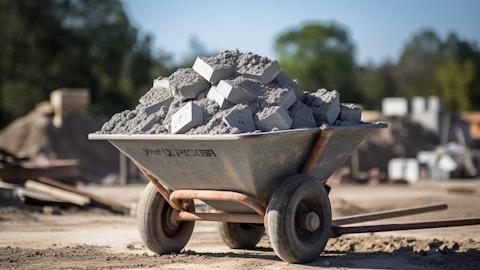Craig Kesler: Anthony, I might just add one thing to that. In terms of the capital investments, as Michael mentioned, I would not anticipate that being in our fiscal 2025. And then in terms of a profitability, look I would just say, we believe this will more than meet our investment hurdle rates and return criteria. So very excited about it, but it is still a ways off for us.
Anthony Pettinari: Okay. That’s very helpful. I’ll turn it over.
Operator: And our next question today comes from Jerry Revich with Goldman Sachs. Please go ahead.
Jatin Khanna: Hi, good morning everyone. This is Jatin Khanna on behalf of Jerry Revich. Could you please talk about the potential for new margin highs for Cement amid rising replacement costs and slowing input costs in the coming quarters?
Craig Kesler: Could you repeat the first part of that question?
Jatin Khanna: Yes sure. Could you please talk about the potential for new margin highs for Cement? amid rising replacement costs and slowing input costs? Thank you.
Craig Kesler: Yes. No. Look it’s very consistent with what we’ve talked about for several years now. We’ve improved the Cement network at Eagle through large M&A over the last decade or so on the assets that we’ve acquired have been high-quality assets. And so then against the backdrop of very limited supply response to improving demand. You have diminishing alternative materials like fly ash. And so that’s led to an environment where we’ve been able to achieve good pricing. And so yes we’ve seen margins improve very nicely and this quarter is in line with that. As we look forward into fiscal 2025 we’ve talked many times over the last several quarters about we would expect to see some lower energy prices especially around fuel. So, we would expect over the rest of the cycle we should continue to be able to expand margins across our Cement network.
Jatin Khanna: Thanks very much. I’ll pass it on.
Operator: Thank you. And our next question today comes from Kevin Gainey with Thompson Davis. Please go ahead.
Kevin Gainey: Hey guys. It’s Kevin on for Adam. I actually maybe wanted to talk a little bit about the California 4 [ph] terminal. It seems to be performing well. And have those assets been absorbed into the network easily? And how are they performing versus kind of when you guys bought them?
Michael Haack: Yes. That asset was a fantastic fit into our operation as we discussed previously with they were absorbed very quickly into the operation and it’s to support that Western market and to support our plants on that side and satisfy our customers’ demand. We’ll continue to integrate that. However, it’s actually came up very fast and very efficiently and is supporting our markets very well.
Kevin Gainey: Good to hear. And then maybe if you guys wanted to go just on Cement margins a little more. Do you — what gives you guys the confidence in sustaining that looking forward?
Craig Kesler: Yes. And just to be clear we look at our margin profile whether you want to call it a trailing 12 months or on an annual period. You certainly have quarters where you’ll have our major maintenance outages like we’ll have in the June quarter. And so we’re really talking about annual margins. And look it comes from a foundation of high-quality assets low-cost position in very good markets. Michael has alluded to many times we’re relatively insulated from imports. So, we’re more in the Heartland part of the country. And so given the market conditions where demand is outpacing supply that generally provides a pricing power to the manufacturers. And you’ve seen that the last couple of years and we’ve got incremental price increases announced for the first half of this year.
And then on the cost side it’s an energy-intensive business and energy prices certainly have stopped being as inflationary as they were a couple of years ago. So, that’s what gives us the confidence as we look at this business at — on an annual basis why we think we can continue to improve margins.
Kevin Gainey: Sounds good. Appreciate it. Thanks guys.
Operator: And our next question today comes from Phil Ng with Jefferies. Please go ahead.
Phil Ng: Hey, guys. Appreciating you’re pretty insulated from imports Craig as you mentioned. But there is the conflict in the Red Sea. Are you seeing any impact out there from imports whether it’s supply and pricing and what that ultimately means for the markets you’re in?
Craig Kesler: Phil no direct impact for us in terms of supply or anything coming across the ocean. But I think it does highlight the risk that imports have that they are subject to global issues whether it’s very specific events as you mentioned or others that could impact timing of ships the trips that they have to take longer trips that are more expensive. So that is the issue with why imports have a restricted ability to impact the U.S. market.
Phil Ng: Are you seeing any upward pressure on import prices just given that dynamic in recent weeks?
Craig Kesler: Ocean freight rates have kind of gone up and down over the last call it six to nine months. Those are impacted by many things. Again, we’re not as large of an importer as others are. So, I can’t say that we’ve seen any direct impact at this point. But I think your point is well made that there are some upward pressures on ocean freight rates.
Phil Ng: Okay. On the Wallboard side the quarter was obviously quite strong from a volume standpoint. Is any of that like tied to like pre-buy I know there was a fall price increase or any of your customers trying to hit these rebates. So my question is, could there be a hangover effect on the demand side for your March quarter? And then I guess bigger picture this year with rates potentially coming back, let’s say, we get back to like 5.5%. How quickly do you see that kind of rippling through? I appreciate there’s a lag, but like how quickly do you kind of see that inflection if you do see one on Wallboard demand?




